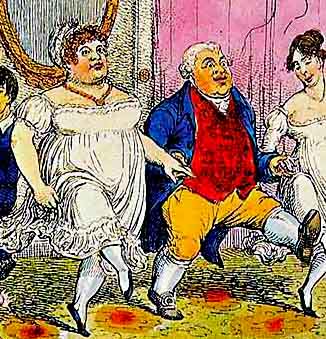Dancing Badly is Not Historically Incorrect
 In trying to recreate historical dance, or any other historical performance art form where sound or film recordings are not available, you constantly run into the question of "what is authentic"?
In trying to recreate historical dance, or any other historical performance art form where sound or film recordings are not available, you constantly run into the question of "what is authentic"?
With social dancing, this is a rather acute question, as the sources for these dances are generally dance manuals. These dance manuals are often very specific on the proper way to perform the dances in question (except when they're not, and assume that everyone already knows the fundamentals of the dances performed - but that's another issue).
Certainly. to dance the dance exactly as described in the book is more than likely correct for some portion of the dancing population of the time, but what if you dance that dance some other way -- is that wrong? Is that unhistorical? Maybe, but then again, maybe not.
I have made a study of historical etiquette books, and compared the ideal world described by the authors with less rosy pictures drawn of the same people, time and place by authors who were not writing etiquette books. The contrast between what the etiquette book proscribed what other authors described is often amusing and always interesting. The most telling however, is when an etiquette writer describes despicable behavior that must be avoided. These tobacco-spitting extremes often tend to be a more accurate description of the zeitgeist than the more refined behavior advocated by the etiquetticians.
The same can be said for dance books. When reading these, I tend to be on the lookout for the author's rants on bad practices of the day, like Thomas Wilson condemning the indecorous tendency of some dancers to sway with the music when they waltzed.
This isn't to say that students of historical dance should not constantly strive to improve their technique, to become more graceful, refined and accomplished; or that dance scholars should not sweat the details and carefully decipher complex passages in surviving sources.
However, this does mean that those who are not fully versed in the finer points need not refrain from participating just because they are not as polished as others on the floor. "Dumbed down" or less refined versions of more complex dances often existed, and it is a useful practice to try to pick out what those simpler or more rambunctious versions might have been from the often inadvertent evidence provided in dance manuals, and the visual evidence of paintings and, frequently, cartoons. Not only can this help provide a more accurate concept of what was really going on on the dance floors of the past, but can also give the less gifted dancers among us a point of entry into this hobby that is not quite as demanding and forbidding as requiring text book perfection as a requisite for participation.
I am not suggesting however, teaching dead-end techniques that cannot evolve into better dancing
I would also like to say to those folks who are struggling with the basics of the Waltz or other historical dance, and not quite getting it, that they should take heart. Many of their great-great-grandparents were as lost as they, and simply did their best, and the best effort of a struggling Victorian was, I am sure, uncannily similar to the best effort of a struggling modern.
In fact, it just might be that your best effort is a more accurate depiction of what your imperfect human ancestors were really dancing, than the balletic scamperings of the "expert" dancer.
Walter







Comments
It's reassuring to know that I'm historically accurate.
Did you pick up any gender-based differences in your readings? My recollections from high school are that, in general, girls took more dance classes while boys played more sports. (This would have led to a school dance with most of the boys glued to the walls, if the scholl hadn't considered partnered dancing sinful in the first place.) Are there any period references to men being able to do just well enough to make their partner look good?
-- T
Posted by: Timothy | December 8, 2009 11:56 AM